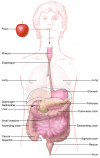Tales from the crypts: regulatory peptides and cytokines in gastrointestinal homeostasis and disease
- PMID: 17200701
- PMCID: PMC1716224
- DOI: 10.1172/JCI30974
Tales from the crypts: regulatory peptides and cytokines in gastrointestinal homeostasis and disease
Abstract
The gastrointestinal (GI) tract is composed of a diverse set of organs that together receive extracorporeal nutrition and convert it to energy substrates and cellular building blocks. In the process, it must sort through all that we ingest and discriminate what is useable from what is not, and having done that, it discards what is "junk." To accomplish these many and varied tasks, the GI tract relies on endogenous enteric hormones produced by enteroendocrine cells and the enteric nervous system. In many instances, the mediators of these tasks are small peptides that home to the CNS and accessory gut organs to coordinate oral intake with digestive secretions. As the contents of ingested material can contain harmful agents, the gut is armed with an extensive immune system. A breach of the epithelial barrier of the GI tract can result in local and eventually systemic disease if the gut does not mount an aggressive immune response.
Figures


References
-
- Gilbert, S.F. 1994.Developmental biology. Sinauer Associates Inc. Sunderland, Massachusetts, USA. 361–368.
-
- Ahlman H., Nilsson The gut as the largest endocrine organ in the body. Ann. Oncol. 2001;12(Suppl. 2):S63–S68. - PubMed
-
- Kelly D., Coutts A.G. Early nutrition and the development of immune function in the neonate. Proc. Nutr. Soc. 2000;59:177–185. - PubMed
-
- Goyal R.K., Hirano I. The enteric nervous system. N. Engl. J. Med. 1996;334:1106–1115. - PubMed
-
- Wilson, K.H. 1999. The gastrointestinal biota. InTextbook of gastroenterology. T. Yamada, D.H. Alpers, L. Laine, C. Owyang, and D. Powell, editors. Lippincott Williams & Wilkins. Philadelphia, Pennsylvania, USA. 624–636.
Publication types
MeSH terms
Substances
Grants and funding
LinkOut - more resources
Full Text Sources
Research Materials

